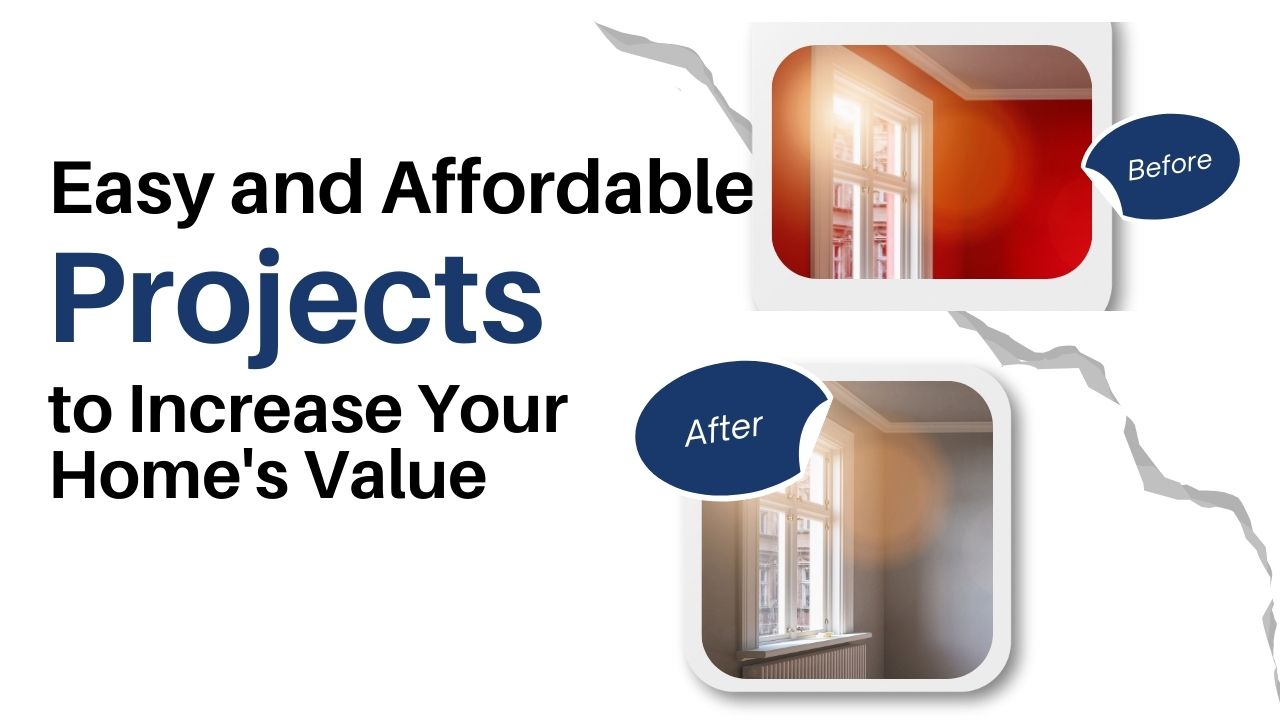 Whether you’re preparing to sell your home or simply want to enhance its appeal, increasing your home’s value doesn’t have to be expensive or time-consuming. With a few affordable projects, you can make your property stand out while staying within your budget.
Whether you’re preparing to sell your home or simply want to enhance its appeal, increasing your home’s value doesn’t have to be expensive or time-consuming. With a few affordable projects, you can make your property stand out while staying within your budget.
1. Boost Curb Appeal
First impressions are everything, and your home’s exterior is the first thing people see. Repaint the front door in an inviting color like navy blue or classic red, replace worn-out doormats, and upgrade your mailbox for a fresh look. Add some colorful potted plants or flower beds near the entryway for extra charm. Maintaining a tidy lawn by mowing, edging, and spreading fresh mulch can also make your home shine.
2. Modernize Lighting Fixtures
Outdated light fixtures can make your home feel older than it is. Replace them with sleek, modern designs or energy-efficient LED lighting. For added versatility, install dimmer switches to create the perfect mood in any room. Don’t forget to update outdoor lighting to enhance safety and nighttime curb appeal.
3. Refresh with Paint
One of the easiest and most cost-effective upgrades is painting. Neutral colors like soft grays, warm beiges, or off-whites make spaces feel larger and more inviting. Don’t just focus on walls—refinishing cabinets, repainting trim, or even giving your garage door a fresh coat can breathe new life into your home.
4. Upgrade Kitchens and Bathrooms
Kitchens and bathrooms sell homes, but full renovations can be pricey. Instead, focus on smaller upgrades like replacing old cabinet hardware with trendy brushed nickel or matte black options. Install a peel-and-stick backsplash for a stylish, modern touch. Replacing faucets, re-caulking sinks, and adding new towel racks can make your bathroom look like new.
5. Add Smart Home Features
Smart home technology appeals to today’s buyers. Start small with devices like a programmable thermostat, smart light bulbs, or a Wi-Fi-enabled video doorbell. These affordable additions make your home feel modern and convenient without requiring significant investment.
6. Declutter and Organize
A well-organized home appears larger and more functional. Clear out clutter, organize storage spaces, and depersonalize rooms to allow buyers to imagine themselves living there. Invest in decorative bins or shelving to keep everything neat and stylish.
7. Create Outdoor Living Spaces
Outdoor spaces are in demand, especially in today’s market. Adding a small patio seating area, stringing up fairy lights, or installing a fire pit can turn an ordinary backyard into a cozy retreat. These upgrades not only add value but also expand your usable living space.
By focusing on these simple and affordable projects, you can maximize your home’s value without spending a fortune. Whether you’re getting ready to sell or just want to enjoy your space more, these upgrades can make a big difference.
 One of the biggest questions future homeowners ask is, “How much do I actually need to save before buying a home?” The answer depends on a few key components, but don’t worry—it’s easier to break down than you might think! Here’s an overview of what you need to save to step into homeownership confidently.
One of the biggest questions future homeowners ask is, “How much do I actually need to save before buying a home?” The answer depends on a few key components, but don’t worry—it’s easier to break down than you might think! Here’s an overview of what you need to save to step into homeownership confidently. For many younger individuals, especially those in Gen Z, the dream of owning a home can feel distant amid rising home prices, mortgage rates, and inflation. With these challenges, it’s easy to wonder if homeownership is truly within reach. While the current housing market may seem daunting, it’s important to know that it’s still possible to become a homeowner with the right strategies and support. With professional guidance, you can navigate the obstacles and achieve your goal of owning a home.
For many younger individuals, especially those in Gen Z, the dream of owning a home can feel distant amid rising home prices, mortgage rates, and inflation. With these challenges, it’s easy to wonder if homeownership is truly within reach. While the current housing market may seem daunting, it’s important to know that it’s still possible to become a homeowner with the right strategies and support. With professional guidance, you can navigate the obstacles and achieve your goal of owning a home. Retirement is an exciting time to enjoy the fruits of your labor, but it can also be a time for change—especially when it comes to your living situation. Downsizing to a smaller home can provide a fresh start, reduce living expenses, and make life simpler. However, finding the perfect smaller home to suit your needs in retirement requires thoughtful consideration and planning. Here are some key tips to help you navigate the process and find a home that will allow you to enjoy your golden years to the fullest.
Retirement is an exciting time to enjoy the fruits of your labor, but it can also be a time for change—especially when it comes to your living situation. Downsizing to a smaller home can provide a fresh start, reduce living expenses, and make life simpler. However, finding the perfect smaller home to suit your needs in retirement requires thoughtful consideration and planning. Here are some key tips to help you navigate the process and find a home that will allow you to enjoy your golden years to the fullest. As more people seek simplicity and focus in their lives, downsizing has become a popular choice among homeowners of all ages. But why is “less” gaining so much appeal? Downsizing offers not just smaller living spaces but also an opportunity to embrace a more fulfilling, efficient, and financially sound lifestyle. Here’s why you may want to consider making the move to a smaller home.
As more people seek simplicity and focus in their lives, downsizing has become a popular choice among homeowners of all ages. But why is “less” gaining so much appeal? Downsizing offers not just smaller living spaces but also an opportunity to embrace a more fulfilling, efficient, and financially sound lifestyle. Here’s why you may want to consider making the move to a smaller home. The home-buying journey is thrilling but can take longer than expected, especially if you need to restart after a purchase falls through. So, how long should you plan for? Generally, you can expect the process to take around four months, divided into three main phases: the search, the offer, and financing.
The home-buying journey is thrilling but can take longer than expected, especially if you need to restart after a purchase falls through. So, how long should you plan for? Generally, you can expect the process to take around four months, divided into three main phases: the search, the offer, and financing.